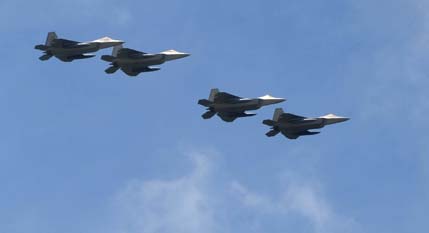The Washington Post’s putative exposé of the F-22 and all its shortcomings, printed on its front page Friday (and picked up as gospel by various wires and blogs over the weekend), was riddled with inaccuracies, according to the Air Force, Lockheed Martin, and our own investigation. The Post said only 55 percent of the F-22 fleet is available for missions “guarding US airspace,” but as we reported recently, the F-22’s combat air forces mission capable rates have been climbing slowly but steadily, and inlate June stood at 62.9 percent, according to Air Combat Command. On Friday, Lockheed Martin, maker of the F-22, said in a statement that the MC rate “has improved from 62 percent to 68 percent from 2004-2009 and we are on track to achieve an 85 percent MCR by the time the fleet reaches maturity,” or 100,000 hours, which should take place next year. The company also said that the mean time between maintenance—the number of hours an F-22 flies before it needs service—rose from 0.97 hours in 2004 to 3.22 hours in Lot 6 aircraft. The Post claimed a figure of 1.7 hours. Direct maintenance man-hours per flying hour have dropped from 18.1 in 2008 to 10.46 in 2009, “which exceeds the requirement of 12,” the company added. The Post used out of date figures from 2004-2008 when the rates were higher because the F-22 was a new system. The Post also trotted out the old school criticism of stealth that it is somehow “vulnerable to rain,” but the company noted that the F-22 is “an all-weather fighter and has been exposed to the harshest climates in the world—ranging from the desert in Nevada and California, extreme cold in Alaska, and rain/humidity in Florida and Guam—and performed magnificently.” The information quoted by the Post “is incorrect,” the company said flatly. While the Post led its piece saying that the F-22 costs more to fly per hour than the F-15 it replaces, it didn’t say whether it had factored inflation or fuel prices into that cost and neglected to point out that the F-15 has no stealth coatings to maintain. An Air Force public affairs spokeswoman said the Post did not contact the service for comment on the story before publication. (Updated July 15, 2009: USAF subsequently amended that statement.) The F-22 passed Follow-On Test and Evaluation Testing in 2005, and in FOT&E II, in 2007, USAF’s test and evaluation outfit rated the F-22 “effective, suitable, and mission capable,” despite the Post’s claims that it “flunked” those evaluations. The Post attributed most of its information to unnamed Defense Department sources.
Washington Post’s putative exposé of the F-22 and all its shortcomings, printed on its front page Friday (and picked up as gospel by various wires and blogs over the weekend), was riddled with inaccuracies, according to the Air Force, Lockheed Martin, and our own investigation. The Post said only 55 percent of the F-22 fleet is available for missions “guarding US airspace,” but as we reported recently, the F-22’s combat air forces mission capable rates have been climbing slowly but steadily, and inlate June stood at 62.9 percent, according to Air Combat Command. On Friday, Lockheed Martin, maker of the F-22, said in a statement that the MC rate “has improved from 62 percent to 68 percent from 2004-2009 and we are on track to achieve an 85 percent MCR by the time the fleet reaches maturity,” or 100,000 hours, which should take place next year. The company also said that the mean time between maintenance—the number of hours an F-22 flies before it needs service—rose from 0.97 hours in 2004 to 3.22 hours in Lot 6 aircraft. The Post claimed a figure of 1.7 hours. Direct maintenance man-hours per flying hour have dropped from 18.1 in 2008 to 10.46 in 2009, “which exceeds the requirement of 12,” the company added. The Post used out of date figures from 2004-2008 when the rates were higher because the F-22 was a new system. The Post also trotted out the old school criticism of stealth that it is somehow “vulnerable to rain,” but the company noted that the F-22 is “an all-weather fighter and has been exposed to the harshest climates in the world—ranging from the desert in Nevada and California, extreme cold in Alaska, and rain/humidity in Florida and Guam—and performed magnificently.” The information quoted by the Post “is incorrect,” the company said flatly. While the Post led its piece saying that the F-22 costs more to fly per hour than the F-15 it replaces, it didn’t say whether it had factored inflation or fuel prices into that cost and neglected to point out that the F-15 has no stealth coatings to maintain. An Air Force public affairs spokeswoman said the Post did not contact the service for comment on the story before publication. (Updated July 15, 2009: USAF subsequently amended that statement.) The F-22 passed Follow-On Test and Evaluation Testing in 2005, and in FOT&E II, in 2007, USAF’s test and evaluation outfit rated the F-22 “effective, suitable, and mission capable,” despite the Post’s claims that it “flunked” those evaluations. The Post attributed most of its information to unnamed Defense Department sources.
KC-46’s Refueling Boom Damaged While Refueling F-22s
July 8, 2025
A U.S. Air Force KC-46 tanker suffered damage to its boom while refueling F-22 Raptors off the coast of Virginia on July 8, Air & Space Forces Magazine has confirmed, with reported radio communication from the crew indicating the boom “detached.”